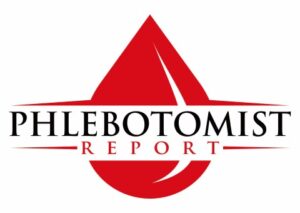Ensuring the cleanliness of a venipuncture site is an important step in the phlebotomy process. Proper cleaning minimizes the risk of infection, ensures sample integrity, and promotes patient safety. In this blog post, we’ll explore the correct methods and guidelines for cleaning a venipuncture site to maintain high standards of care.
Why Cleaning the Site Matters
Cleaning the venipuncture site serves several important purposes:
- Prevents Infection: Removing bacteria, dirt, and other contaminants reduces the risk of introducing pathogens into the bloodstream. Even though you are using a sterile needle, if the site is not cleaned, bacteria on the skin surface may adhere to the outside of the needle and be introduce to the vein or blood.
- Ensures Patient Safety: Proper cleaning reduces complications such as severe blood infection (septicemia) or tissue (cellulitis).
Supplies Needed for Cleaning
Before beginning the venipuncture process, gather the necessary supplies:
- Alcohol prep pads (70% isopropyl alcohol)
- Chlorhexidine swabs or iodine pads (as required)
- Gloves (sterile, depending on the procedure)
- Gauze pads
- Sharps/biohazard container (for proper disposal of used materials)
Step-by-Step Guide to Cleaning the Venipuncture Site
1. Prepare the Patient and Environment
- Ensure the patient is seated or lying down comfortably.
- Verify patient identity and confirm the procedure.
- Wash your hands thoroughly with soap and water or use an alcohol-based hand sanitizer.
- Where gloves.
2. Select the Venipuncture Site
- The most common site is the antecubital fossa (inner elbow), but alternative sites like the back of the hand may be used if needed.
- Palpate the vein to confirm its location and accessibility.
3. Clean the Site
- Use an alcohol prep pad or other antiseptic solution (e.g., chlorhexidine or iodine) to clean the site.
The Technique:
- The Clinical and Laboratory Standards Institute (CLSI) no longer advises using a circular target motion for arm cleansing. Instead, their research shows that back-and-forth friction is more effective than circular cleansing.
- Their guidelines recommend cleaning the site with friction, using a clean gauze pad with a 70% isopropyl alcohol solution or a commercially prepared alcohol pad. Allow the alcohol to air dry for about one minute before performing venipuncture. This ensures proper disinfection, reduces the risk of specimen hemolysis, and minimizes patient discomfort.
4. Avoid Contaminating the Site
- During the procedure, nothing should come into contact with the cleansed site. The phlebotomist must avoid touching the site after cleaning. If re-palpation is necessary, the phlebotomist should change gloves and re-clean the site. Using a cleaned glove tip to palpate the site is not recommended.
- Ensure that no equipment, including the ends of the tourniquet or gauze, touches the cleansed area. If there is any suspicion that the needle touched the site before insertion, discard the needle, re-clean the site, and use a new needle to repeat the procedure.
Special Considerations for Different Antiseptics
- Alcohol (70% Isopropyl Alcohol): Effective for most routine blood draws. Ensure the site dries fully before proceeding to prevent discomfort or hemolysis.
- Chlorhexidine: Often used for patients with allergies to alcohol or iodine. Preferred for procedures requiring a higher level of sterility, such as blood culture collection.
- Iodine: Provides broader antimicrobial coverage. May cause skin irritation in some patients and requires removal with alcohol after the procedure.
Common Mistakes to Avoid
- Skipping Hand Hygiene: Always wash your hands or sanitize them before and after the procedure.
- Not Allowing the Site to Dry: Wiping or blowing on the site to speed up drying negates the antiseptic’s effectiveness.
- Recontaminating the Site: Touching the cleaned area with unsterile objects introduces new contaminants.
- Using Expired or Improper Supplies: Always check the expiration date on antiseptic pads and ensure they are properly stored.
Patient-Specific Considerations
- Patients with Allergies: Confirm any allergies to alcohol, iodine, or other antiseptic solutions. Use alternative cleaning agents if necessary.
- Pediatric Patients: Children may require extra reassurance. Explain each step to alleviate fear.
- Elderly Patients: Aging skin is more fragile. Be gentle when cleaning to prevent irritation.
- Immunocompromised Patients: Use stricter aseptic techniques to reduce infection risks.
Post-Procedure Cleaning
After completing the venipuncture:
- Dispose of Supplies Properly: Discard used alcohol pads, gauze, and gloves in appropriate biohazard containers. Dispose of the needle in a sharps container.
- Clean the Work Area: Wipe down surfaces with an appropriate disinfectant to prepare for the next procedure.
- Document the Procedure: Follow your facilities procedures for documenting like noting the site cleaned, the antiseptic used, and any patient reactions or complications.
Conclusion
Cleaning the venipuncture site is a simple yet important step in ensuring patient safety and sample integrity. While it may seem simple, if not done or done properly, it can affect test results or bring about infection for the patient. Ensure that you cleaning the venipuncture site before inserting the needle into the vein for the best results.
